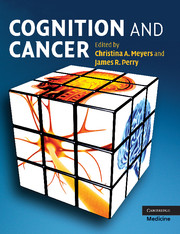Book contents
- Frontmatter
- Contents
- List of contributors
- Preface
- Section 1 Cognition and the brain: measurement, tools, and interpretation
- Section 2 Effects of cancer and cancer treatment on cognition
- 7 Biological bases of radiation injury to the brain
- 8 Cognitive dysfunction related to chemotherapy and biological response modifiers
- 9 Effect of hormones and hormonal treatment on cognition
- 10 Low-grade gliomas
- 11 High-grade gliomas
- 12 Brain metastases
- 13 Primary central nervous system lymphoma
- 14 Childhood brain tumors
- 15 Neurofibromatosis
- 16 Hematological malignancies
- 17 Paraneoplastic disorders
- 18 Symptomatic therapies and supportive care issues
- 19 Animal models and cancer-related symptoms
- Section 3 Interventions and implications for clinical trials
- Index
- Plate section
- References
13 - Primary central nervous system lymphoma
Published online by Cambridge University Press: 13 August 2009
- Frontmatter
- Contents
- List of contributors
- Preface
- Section 1 Cognition and the brain: measurement, tools, and interpretation
- Section 2 Effects of cancer and cancer treatment on cognition
- 7 Biological bases of radiation injury to the brain
- 8 Cognitive dysfunction related to chemotherapy and biological response modifiers
- 9 Effect of hormones and hormonal treatment on cognition
- 10 Low-grade gliomas
- 11 High-grade gliomas
- 12 Brain metastases
- 13 Primary central nervous system lymphoma
- 14 Childhood brain tumors
- 15 Neurofibromatosis
- 16 Hematological malignancies
- 17 Paraneoplastic disorders
- 18 Symptomatic therapies and supportive care issues
- 19 Animal models and cancer-related symptoms
- Section 3 Interventions and implications for clinical trials
- Index
- Plate section
- References
Summary
Introduction
Primary central nervous system lymphoma (PCNSL) is a relatively rare non-Hodgkin's lymphoma that arises within the CNS. Until recently, it accounted for only 1% of all primary brain tumors, but its incidence increased threefold in immunocompetent populations from 1988 to the time of writing (Eby et al., 1988). With a median age at diagnosis of 60 years (Peterson & DeAngelis, 1997), PCNSL is a disease of middle and late adult life, and it is slightly more common in males (O'Neill & Illig, 1989). It is an infiltrative tumor most often located in the periventricular region and subcortical gray matter (Grant & Isaacson, 1992) (Figure 13.1). Leptomeningeal involvement is present in approximately one-third of patients at diagnosis (Peterson & DeAngelis, 1997), and the eye is another site of multifocal CNS involvement in about 25% of patients (Peterson et al., 1993). On neuroimaging studies, PCNSL is identified as contrast-enhancing in 90% of cases, and multifocal lesions occur in approximately 40% of patients (DeAngelis, 1995).
Diagnosis and treatment
Patients may present with focal neurological signs, such as weakness, gait disturbance, language dysfunction, or seizures. Generalized symptoms of increased intracranial pressure, headache, or progressive cognitive decline may also occur at presentation. The diagnosis of PCNSL involves stereotactic brain biopsy or demonstration of malignant lymphocytes in the cerebrospinal fluid (CSF) or vitreous in cases of ocular involvement. Surgical resection is often not beneficial, and the deep-seated nature of most lesions increases the risk of possible surgical complications (DeAngelis et al., 1990).
Information
- Type
- Chapter
- Information
- Cognition and Cancer , pp. 187 - 197Publisher: Cambridge University PressPrint publication year: 2008
